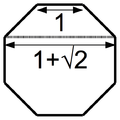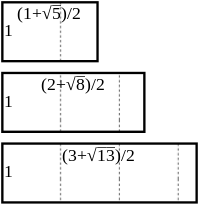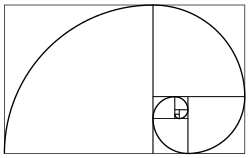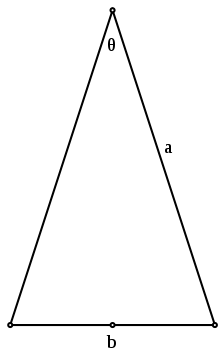Metallic mean
The metallic means (also ratios or constants) of the successive natural numbers are the continued fractions:
| Metallic means (Metallic ratios) | Class | ||
|---|---|---|---|
| N | Ratio | Value | (Type) |
| 0: | 0 + √4/2 | 1 | |
| 1: | 1 + √5/2 | 1.618033989[lower-alpha 1] | Golden |
| 2: | 2 + √8/2 | 2.414213562[lower-alpha 2] | Silver |
| 3: | 3 + √13/2 | 3.302775638[lower-alpha 3] | Bronze |
| 4: | 4 + √20/2 | 4.236067978[lower-alpha 4] | |
| 5: | 5 + √29/2 | 5.192582404[lower-alpha 5] | |
| 6: | 6 + √40/2 | 6.162277660[lower-alpha 6] | |
| 7: | 7 + √53/2 | 7.140054945[lower-alpha 7] | |
| 8: | 8 + √68/2 | 8.123105626[lower-alpha 8] | |
| 9: | 9 + √85/2 | 9.109772229[lower-alpha 9] | |
| ⋮ | |||
| n: | n + √4 + n2/2 | ||


The golden ratio (1.618...) is the metallic mean between 1 and 2, while the silver ratio (2.414...) is the metallic mean between 2 and 3. The term "bronze ratio" (3.303...), or terms using other names of metals (such as copper or nickel), are occasionally used to name subsequent metallic means.[1][2] The values of the first ten metallic means are shown at right.[3][4] Notice that each metallic mean is a root of the simple quadratic equation: , where is any positive natural number.
As the golden ratio is connected to the pentagon (first diagonal/side), the silver ratio is connected to the octagon (second diagonal/side). As the golden ratio is connected to the Fibonacci numbers, the silver ratio is connected to the Pell numbers, and the bronze ratio is connected to OEIS: A006190. Each Fibonacci number is the sum of the previous number times one plus the number before that, each Pell number is the sum of the previous number times two and the one before that, and each "bronze Fibonacci number" is the sum of the previous number times three plus the number before that. Taking successive Fibonacci numbers as ratios, these ratios approach the golden mean, the Pell number ratios approach the silver mean, and the "bronze Fibonacci number" ratios approach the bronze mean.
Properties



These properties are valid only for integers m, for nonintegers the properties are similar but slightly different.
The above property for the powers of the silver ratio is a consequence of a property of the powers of silver means. For the silver mean S of m, the property can be generalized as
where
Using the initial conditions K0 = 1 and K1 = m, this recurrence relation becomes
The powers of silver means have other interesting properties:
- If n is a positive even integer:
Additionally,

Also,
In general:
The silver mean S of m also has the property that
meaning that the inverse of a silver mean has the same decimal part as the corresponding silver mean.
where a is the integer part of S and b is the decimal part of S, then the following property is true:
Because (for all m greater than 0), the integer part of Sm = m, a = m. For m > 1, we then have
Therefore, the silver mean of m is a solution of the equation
It may also be useful to note that the silver mean S of −m is the inverse of the silver mean S of m
Another interesting result can be obtained by slightly changing the formula of the silver mean. If we consider a number
then the following properties are true:
- if c is real,
- if c is a multiple of i.
The silver mean of m is also given by the integral
Trigonometric Expressions
| N | Trigonometric Expression | Associated Regular Polygon |
|---|---|---|
| 1 | Pentagon | |
| 2 | Octagon | |
| 3 | Tridecagon | |
| 4 | Pentagon | |
| 5 | 29-gon | |
| 6 | 40-gon | |
| 7 | ||
| 8 | Heptadecagon | |
| 9 |
See also
Notes
- Sloane, N. J. A. (ed.). "Sequence A001622 (Decimal expansion of golden ratio phi (or tau) = (1 + sqrt(5))/2)". The On-Line Encyclopedia of Integer Sequences. OEIS Foundation.
- OEIS: A014176, Decimal expansion of the silver mean, 1+sqrt(2).
- OEIS: A098316, Decimal expansion of [3, 3, ...] = (3 + sqrt(13))/2.
- OEIS: A098317, Decimal expansion of phi^3 = 2 + sqrt(5).
- OEIS: A098318, Decimal expansion of [5, 5, ...] = (5 + sqrt(29))/2.
- OEIS: A176398, Decimal expansion of 3+sqrt(10).
- OEIS: A176439, Decimal expansion of (7+sqrt(53))/2.
- OEIS: A176458, Decimal expansion of 4+sqrt(17).
- OEIS: A176522, Decimal expansion of (9+sqrt(85))/2.
References
- Vera W. de Spinadel (1999). The Family of Metallic Means, Vismath 1(3) from Mathematical Institute of Serbian Academy of Sciences and Arts.
- de Spinadel, Vera W. (1998). Williams, Kim (ed.). "The Metallic Means and Design". Nexus II: Architecture and Mathematics. Fucecchio (Florence): Edizioni dell'Erba: 141–157.
- Weisstein, Eric W. "Table of Silver means". MathWorld.
- "An Introduction to Continued Fractions: The Silver Means", maths.surrey.ac.uk.
- M, Teller. "Polygons & Metallic Means". tellerm.com. Retrieved 2020-02-05.
Further reading
- Stakhov, Alekseĭ Petrovich (2009). The Mathematics of Harmony: From Euclid to Contemporary Mathematics and Computer Science, p. 228, 231. World Scientific. ISBN 9789812775832.
External links
- Stakhov, Alexey. "The Mathematics of Harmony: Clarifying the Origins and Development of Mathematics", PeaceFromHarmony.org.
- Cristina-Elena Hrețcanu and Mircea Crasmareanu (2013). "Metallic Structures on Riemannian Manifolds", Revista de la Unión Matemática Argentina.
- Rakočević, Miloje M. "Further Generalization of Golden Mean in Relation to Euler's 'Divine' Equation", Arxiv.org.
